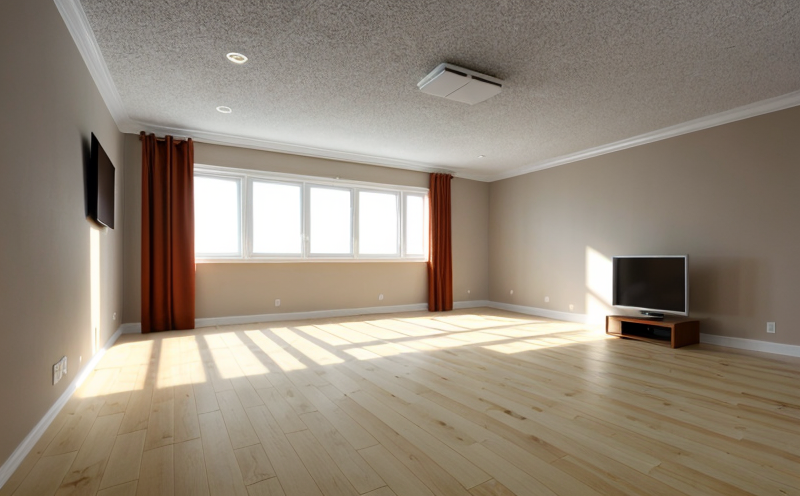ISO 16283 2 Field Measurement of Impact Sound Insulation Validation Method Development Test
The ISO 16283-2 standard provides a comprehensive framework for validating the performance of impact sound insulation in real-world conditions. This method is critical for ensuring that building materials and constructions effectively reduce noise transmission, thereby enhancing occupant comfort and privacy.
Impact sound insulation testing evaluates the ability of a construction or material to prevent the passage of impact-induced sound from one space to another. The test simulates the real-life conditions under which these insulations are expected to function—such as footsteps, furniture movement, and other impacts that occur within buildings.
The standard specifies detailed procedures for conducting field measurements using a tapping machine with interchangeable heads to simulate different types of footfalls. The testing setup involves two rooms separated by the construction or material under test. A calibrated tapping machine is used to generate impact sounds on one side, and sound pressure levels are measured on both sides.
The acceptance criteria for this method focus on the maximum permissible sound transmission class (STC) value. This value is derived from the measured sound pressure levels in the receiving room relative to a reference level. Compliance with these criteria ensures that the construction or material meets the required performance standards for noise reduction.
In practice, testing adheres to strict protocols to ensure accuracy and reliability. Specimens are prepared according to specified dimensions and conditions to simulate real-world scenarios. Instrumentation includes precision tapping machines and sound level meters capable of capturing accurate data under various environmental conditions.
The test setup is critical for obtaining valid results. The receiving room must be acoustically treated to minimize reflections, ensuring that the measurements accurately reflect the performance of the insulation. Environmental factors such as temperature and humidity are also monitored and controlled during testing to maintain consistency.
Once data collection is complete, it is analyzed using statistical methods to determine the STC value. This value is compared against the target level specified in the contract or regulatory requirements to assess compliance. A detailed report summarizing the test setup, procedures, results, and conclusions is prepared for submission to relevant authorities.
Understanding the nuances of this testing method requires expertise in acoustics, vibration, and noise control. Our team at Eurolab has extensive experience in implementing ISO 16283-2 tests across various projects, ensuring that our clients receive accurate and reliable results every time.
Why It Matters
The importance of impact sound insulation testing cannot be overstated. In modern buildings, noise pollution is a significant concern, affecting both comfort and health. Effective impact sound insulation helps to create more peaceful environments by minimizing unwanted noise transmission.
In residential settings, this is particularly crucial for maintaining privacy between rooms or apartments. In commercial spaces, such as offices or hotels, it ensures that employees can focus on their work without distractions from adjacent areas. Compliance with relevant standards also provides legal protection and helps avoid potential disputes over noise complaints.
The ISO 16283-2 standard is widely recognized for its robustness in evaluating the performance of impact sound insulation under field conditions. By adhering to this method, builders and developers can ensure that their constructions meet the highest quality standards and deliver a superior acoustic experience to occupants.
Our services go beyond mere compliance; they focus on delivering measurable improvements in noise reduction. This not only enhances user satisfaction but also contributes positively to overall environmental sustainability by promoting quieter communities and workplaces.
Eurolab Advantages
At Eurolab, we pride ourselves on providing cutting-edge testing solutions tailored specifically for our clients' needs. Our expertise in acoustics, vibration, and noise control allows us to offer unparalleled accuracy and reliability when conducting ISO 16283-2 tests.
We employ state-of-the-art equipment and follow internationally recognized standards meticulously to ensure precise measurement and analysis. Our experienced technicians are dedicated professionals who understand the complexities involved in this type of testing, ensuring consistent high-quality results.
Our commitment to excellence is further demonstrated through our comprehensive reporting services. Detailed reports not only summarize the test findings but also provide actionable insights for improving future designs and constructions. This allows clients to make informed decisions based on concrete evidence rather than assumptions or guesswork.
In addition, Eurolab offers a full suite of related services that complement our core testing capabilities. From preliminary consultations to post-test analysis support, we strive to provide a seamless experience from start to finish. Whether you're looking for assistance with selecting appropriate materials or optimizing design parameters, we have the expertise and resources to assist you.
Use Cases and Application Examples
| Application Example | Description |
|---|---|
| Residential Construction | In residential projects, ensuring effective impact sound insulation is essential for creating quiet living spaces. This test helps verify that walls and floors meet the required STC levels to block noise from one room to another. |
| Commercial Buildings | For commercial buildings like offices or hotels, maintaining a peaceful environment is vital for productivity and guest satisfaction. ISO 16283-2 testing ensures that the construction provides adequate sound insulation against various sources of noise. |
| Hospital Settings | In hospitals, minimizing noise levels helps patients rest better and improves overall care quality. This test ensures that medical facilities adhere to strict noise control standards, enhancing patient recovery rates. |
| Education Facilities | Impact sound insulation is crucial in educational institutions to maintain a conducive learning environment free from external disturbances. The test verifies compliance with noise reduction requirements, ensuring students can focus better during classes. |
| Public Spaces | In public spaces such as parks or recreational areas, maintaining tranquility is important for visitor enjoyment. This testing ensures that the surrounding constructions contribute positively to the acoustic comfort of these spaces. |
| Sound Studio Design | For sound studios, precise control over background noise is paramount. This test helps designers create environments where audio clarity remains unaffected by external sounds. |





